#to you on geostationary orbit
Explore tagged Tumblr posts
Text
不協和音のわたしたち | cosmomule (feat. mekakushe)
#不協和音のわたしたち#Can't understand each other#cosmomule#mekakushe#静止軌道上空のあなたへ#to you on geostationary orbit#my post#musik
2 notes
·
View notes
Text
This harkens back (forward? widdershins?) to my favorite passage in the entire trilogy:


One of many sentences in HtN that keep me up at night
#I have a normal amount of feelings about this#I could write a whole book on the theme of falling in The Locked Tomb#Does tazmuir know about geostationary orbits#It's infinite self-sustaining freefall#“I don’t like the part just before you let go and I don’t like the part where you hit the floor#but I like the letting go.”
2K notes
·
View notes
Text
Head Home [RP]
with @see-you-in-the-sky
John's latest rotation has been sixteen days over schedule.
International Rescue has been absurdly busy dealing with the fallout of a category five hurricane on the American east coast, and, fielding hundreds of calls to get the assistance on the ground to where it's needed most, John's been on the wire for pretty much 24-7... as much as 24-7 can be observed in geostationary orbit.
John is bone tired, and more than ready to head home.

Scott is, as John understands it, dragging a protesting Alan up by the ear in Thunderbird Three to come relieve him. John stifles a yawn in the back of his hand, ghosting his fingers over Five's switchboard to check everything is in place before he leaves it to his little brother. The light that signifies Three docking blinks at him from the left of his palm, and there's a quirk to the corners of John's mouth as he holds down the intercom button.
"Gee, it sure is good to see you, Scott. Beginning airlock cycle now."
37 notes
·
View notes
Text
The aliens arrived in their toroidal flying saucers--enormous gossamer-like structures big enough to put Jupiter in the hole. They projected bodies down to Earth on long threads, and complained.
"What happened?" they pleaded with our planetary scientists.
An awfully open-ended question, but the planetary scientists threw up their hands and explained the current state of the field, about the theory of planetary aggregation and various hypotheses to explain how each of the planets ended up where they are today. The aliens nodded along skeptically at times, but they seemed especially disappointed by the Lunar geologists.
"Excuse us," their leader said politely, rising into the sky towards geostationary orbit on a great thread.
And so it was for the next few decades that the aliens set to work correcting what they saw as the great mistakes of the solar system's formation. Perhaps Venus never cooled down enough to avoid a runaway greenhouse effect, or maybe something about its specific volatile mass had been off. Either way, it was the first to be treated. By the time it was done, perhaps 20 years in, it was a blue world with brown continents and white clouds. While another saucer had come to work its magic on Mars, the first saucer returned.
"Eh, we'll need you to give planet two a good head start with the whole biosphere thing. We hadn't bargained on life starting up there halfway through the lifespan of the Sun. If it's no trouble, that is."
A new habitable planet provided the space program no shortage of funding!
Mars was finished, just a few years later, a comparatively simpler job. The aliens advised humans not to interfere with this one just yet, to perhaps give it a few hundred megaannum or so for the life to diversify and develop before contaminating it.
But the saucers didn't leave. They seemed to drift throughout the inner solar system. They took some curious expeditions to Europa and Enceladus--robotic NASA spacecrafts recorded deep probing threads piercing the ice--but didn't seem impressed.
They kept returning to the Moon.
At last, the aliens projected down on their long threads to a university. "You're sure that's how it happened?" they said.
The lunar-planetary scientists showed the alien ambassadors rocks from the Apollo and Artemis expeditions, computer simulations of various types of giant impacts, of synestias and hours-long instant formations and debris disks and gas instability, of an oversized iron core and large low-shear-velocity-provinces.
"We think the water on Earth may even have been delivered through a giant impact from a KBO, though there's some concerns about isotopic ratios."
"No, no," said the alien. "The initial coorbital hypothesis is the correct one."
The alien sighed--it had picked up human body language well over the past 35 years--"This just won't do," it said. It left the building, shaking its head. "It just won't do."
The planetary scientists ran after the alien, as it started reeling its thread back. "Wait!" they said. "What are you going to do?"
"This Moon thing of yours just isn't big enough to hold onto an atmosphere. I'm afraid it's not good enough."
The aliens rose into the sky.
Within a few months the Moon had been lost from the sky, and a years later had been relocated to the L4 lagrange point. The aliens came back, apologetically. "Terribly sorry," they said, "We're in the final phases of the plan," they said.
The Earth Emergency Government representative stepped forward. "Final… phases?" he said.
"Theia was always meant to be a trojan of your Earth, you see. Something must have gone wrong when the gas disk dissipated."
"I don't understand," the representative said.
"My apologies," the alien said, "I'm used to dealing with your planetary researchers."
Many masses of threads now fell gracefully from the skies. When they touched down, they effortlessly bored deep holes. The ground shook. The representative's heart rate skyrocketed.
"It's just that we're going to have to repossess the planet Theia now."
#science fiction#scifi#planetary science#theia#the moon#microfic#flash fic#flash fiction#giant impact
28 notes
·
View notes
Text
Jerid's Sortie Order (1987)

"Hey, Zaku, surely it doesn't take you two and a half years to read a book." It does when you set it aside for several months to watch a ton of hella mid isekai anime, start the first G-Saviour novel and go even slower because of all the hella mid isekai anime, and then forget about both for several more months because you're too lazy to do language practice after work. But I did it eventually!
As with Char's Return, this is a single-player RPG with choose-your-own-adventure branching and turn-based combat. This time, you're Jerid Messa in the final days of his Titans training. When guerrillas take over a Federation base and threaten to use their own experimental technology against them, Bask Om gives Jerid 24 hours to save the day. Summary under the cut.
Setting
January, UC 0087. Buckland Base in Alaska hosts several experimental technologies away from prying eyes. Research into artificial Newtypes has begun. It also has a perimeter defense system powered by Kerberos, a satellite power station in geostationary orbit above the base. Using "Wave Catchers," microwaves received from Kerberos are converted into electricity that can power high-output beam weaponry, which could enhance the defenses of bases without large nuclear reactors. Kerberos itself could also be used as an orbital weapon...
In the Bering Sea to the west, Jerid Messa, Emma Sheen, and Kacricon Cacooler are five months into their special training program to become Titans officers. They are aboard the Graf Zeppelin, a massive attack carrier initially developed by Zeon but captured and completed by the Federation. The program is nicknamed "Top Gundam," a portmanteau constructed from the old US Navy's flight academy and the ace machine of the One Year War.
Characters
Jerid Messa: You assume the role of 23-year-old Jerid Messa at the end of his training. As the protagonist, Jerid doesn't come across as abrasive or comically evil as his anime counterpart.
Emma Sheen: A fellow student at Top Gundam. Described as a woman of Eastern descent with graceful features and the air of an honors student.
Kacricon Cacooler: A fellow student at Top Gundam. A rough, veteran-looking guy who Jerid has known for longer than Emma.
Bask Om: A high-ranking officer within the Titans who arrives at the Graf Zeppelin with a dangerous, time-sensitive, mission.
Alaska Native old man: Helps Jerid after a guerrilla encounter in a village. He has little intel but leaves an impact on Jerid by explaining his reasons for living traditionally.
Alaska Native young girl: The old man's granddaughter, who helps rally Jerid's fighting spirit and gives him another reason to complete the mission.
Ex-Zeon soldier: Crash-landed in the region during the One Year War, was healed by the Alaska Natives who found him, and decided to live in their village after growing tired of the war.
Enemy commander: A middle-aged man described as having sharp eyes despite an otherwise scrawny, hollow appearance.
Tom Cruising: Senior Crewman with the local guard. He shows up at the end to congratulate Jerid on his success and remind you that this is supposed to be loosely based on Top Gun.
Mechanics
MS-06MH Marine Hizack: One of three MS that Jerid can select for the mission; it confers an advantage in underwater combat but cannot use beam weapons. Its model number suggests that, despite the name, it's more likely to be the MS-06M/MSM-01 Zaku Marine Type that appeared in Zeta.
MS-09 Dom Blizzard Type: Presumably equivalent to the MSV-R Dom Cold Climate Type. It also appears in the game text as the MS-09F2.
MS-14A Gelgoog
MS-17B Galbaldy Alpha
MS-87D Nashorn: "Zeon's Phantom MS" that saw limited deployment during the One Year War, armed with a hyper rifle.
MSM-10 Zock
MAN-07 Grabro
RMV-05 Guntank Hover: Presumably derived from the RMV-1 as a hovering vehicle, although its in-book art depicts a machine with an upper body that's closer to the original Guntank but with a mono-eye head.
RGC-80 GM Cannon
RGM-79R Gundam Copy Type: Shares the same model number as retrofitted GMs that led to the development of the RMS-179; in the game, though, it's a clone of the original Gundam with Amuro's combat data.
RMS-179 GM II: One of three mobile suits Jerid can select for the mission; it has more HP than the Marine Hizack and is the only unit that can use a beam rifle.
RMS-106 Hizack: One of three mobile suits Jerid can select for the mission. It's used in the training exercises before the mission starts and has stronger armor than either the Marine Hizack or GM II.
RMS-117 Galbaldy Beta
ORX-003 Domingo: Described as the predecessor of the ORX-005 Gaplant, a transformable mobile suit with exceptionally high speed and aerial combat capabilities.
MAX-09 Dura: A behemoth MS nearly 70 meters tall and weighing 685 tons, it was developed from the Big Zam. The Dura has multiple high-output beam cannons, a deflection shield that weakens beam attacks, and, learning from the Big Zam's defeat, sub-arms with close-combat weapons. It is the final boss. Confusingly listed in the book's MS table as the MAX-09, on the back cover as the MAX-07, and in the game text as the MAX-11.
FF-3 Saberfish
M-4A3 Salamander: A hovertank armed with missiles.
Fa-223 Drache: Described as a combat helicopter, but its in-game artwork looks more like the fusion of a Luggun and a Dopp.
Dodai Kai
Story
Aboard the Graf Zeppelin, Jerid, Emma, and Kacricon go through their last big round of combat training. In a simulator, Jerid pilots a Hizack against up to three opponents: a damaged GM II, another Hizack, and the Gundam with Amuro's combat data. After simulator training is completed, the three participate in mock aerial combat aboard Hizacks riding Dodai Kais. (The number of opponents you defeat during the training phase determines how many skill points you start with.)
As aerial training concludes, you're all summoned by Bask Om. He explains that guerrillas have captured nearby Buckland Base -- and by extension, Kerberos, which is controlled remotely -- and are demanding that the Federation government release Zeon war prisoners. Because of the beam turrets powered by the Kerberos satellite, directly attacking the base is not an option. Neither is destroying the satellite itself. What about the Wave Catchers? Their locations are a closely-guarded secret, so they have to be found first.
If their demands aren't met within 30 hours, the guerrillas will use Kerberos to attack colonies. An organization as proud and just as the Titans could never allow a laser to strike a colony; the very idea is preposterous. Due to Minovsky Particle interference, someone has to locate and destroy the Wave Catchers and then call for reinforcements using laser-line communication from the Buckland Base control tower. The mission is assigned to Jerid, the one with the highest marks among the three trainees.
Once Jerid selects a machine and weapons, he departs the Graf Zeppelin in a high-speed capsule to one of two locations on the Alaskan coast. The mission area is a 6x4 grid and moving to an adjacent cell takes two hours, although this is reduced to one if a high-mobility item is equipped. All objectives must be achieved within 24 hours.
Jerid is free to roam the grid, encountering various enemies (defeating them earns more skill points) and procuring items that will help him later. Several, such as infrared goggles, are for the eventual infiltration of Buckland Base. Others are additional ammo or different weapons for his MS, in addition to repair docks that fully restore the unit's HP but require two hours to use. A few areas are also protected by minefields.
With the exception of two Alaska Native villages, the region is sparsely populated. He is more likely to run into a guerrilla than a civilian, although the latter do have items and information if you are able to converse. A young girl in one village gifts him a protective amulet that fits neatly into the breast pocket of his normal suit, which certainly isn't foreshadowing anything.
After destroying all three Wave Catchers and crossing the minefield outside Buckland Base, Jerid breaks into the facility in search of the communications room. There are infrared sensors along the way that must be avoided and gun-toting troops guard most routes. After reaching the room and sending the laser communication, the enemy commander and his men attack, but Jerid survives a gunshot thanks to the protective amulet. He still blacks out.
When Jerid wakes up, he's in a large dome under the base where the enemy commander has graciously provided him with his MS, repaired and rearmed, for a fight to the death against two artificial Newtypes loaded with Char and Amuro's combat data. Seeing the Gundam, Jerid recalls a family trip to Ireland where he met a girl who showed him a commemorative photobook of the machine. Jerid defeats both and the commander angrily prepares to destroy the dome from the inside, but since Jerid successfully called for help, Emma and Kacricon arrive to prevent the dome from collapsing on him.
Upon exiting the dome, the enemy deploys its final card, the Dura. It immediately bathes the area in fire and threatens to destroy the Graf Zeppelin approaching offshore. Jerid, Emma, and Kacricon all fight together and eventually bring the lumbering hulk down. (Although it's not a game over if either Emma or Kacricon die, this does lead to a bad ending where Jerid dies from extreme fatigue at the end of the mission.) With the Dura's defeat, the Buckland Base staff are rescued, as are civilians from the two villages who were captured after you left. You are reunited with the young girl, who reminds you of the one you met in Ireland years ago.
Jerid, Emma, and Kacricon return victorious to the Graf Zeppelin. Jerid does a victory roll on the deck, causing Bask to spill hot coffee on himself in the control room because, remember, this is Top Gun. At the debriefing, Bask promotes them all to Lieutenant Junior Grade and offers them the chance to become Gundam Mk. II test pilots (Two months later, the AEUG infiltrates Green Oasis and any character growth that Jerid experienced while completing this mission is lost when he encounters an autistic teenager.)
So there you have it!
Most of the story is contained the prologue and epilogue, as there's no canonical path to completing the mission. Only the Wave Catcher cells and the young girl's village are hard requirements, but given where they are relative to each other, you need to find a high-mobility item as early as possible. Same deal with items for base infiltration; you need at least two of the infrared goggles, wire rope, and landmover to reach the comms room before getting caught. There's probably also a fine line you have to walk between avoiding battles and fighting them for skill points, because repairs are expensive time-wise.
Dunno what's next; I certainly have no shortage of books to try!
27 notes
·
View notes
Text

we care not whether this is fake, it made us picture jesus locked in a geostationary orbit and that improved our evening so here you go
12 notes
·
View notes
Note
wait Lew I have a space law question, how do we decide who gets to put satellites where? like I know there's thousands of satellites in low Earth orbit, how close can someone put a new satellite to old ones? how crowded is that situation? and there's a buncha scientific satellites (the only space thing I know something about) that are all in very similar orbits, who gets to add a satellite to that train? do people fight over spots?
good question! generally, there is a freedom of the exploration and use of outer space, so everyone can do what they want up there as long as they don't violate any other laws - and, as long as outer space remains "free for exploration and use by all States without discrimination of any kind, on a basis of equality and in accordance with international law" (Art I OST). now, what the fuck does that mean, i hear you ask, and to that i shrug and smile politely because we are still figuring that out. outer space is becoming increasingly congested, and it's use is certainly not equal - while the USA owns HALF of the satellites in space, there are many countries who have launched no objects yet, even though many critical infrastructures depend on the access to space. you see the problem.
fights over spots do happen, especially in GEO. this is the geostationary orbit, which is 35,786 km above the equator - satellites here orbit as fast as the earth turns and therefore remains over the same spot of the earth forever, which is crucial for telecommunication (imagine adjusting your satellite dish every minute to watch TV). and those spots are very coveted, as they are very, very limited. there have been multiple attempts of the UN to regulate this on an equitable basis, none of them successful (in my opinion).
equitable access to outer space remains a huge problem and inequalities on earth are often exacerbated in outer space - which is why we need national regulation that actually implements Art I OST instead of ignoring it! (looking at you, US of fucking A)
44 notes
·
View notes
Text
Dr. Stone chapter 2D trivia post
Spoilers ahead !
Check out too, my trivia post for the previous chapter.

This changes everything, folks! however, we gotta start from the start.

Chrome's drawn this roadmap, and he seems to pretend to build yet another of his silly storehouse towers like he's done around the globe. Next stop, the moon.



This confused me for a while until it was pointed out to me that "EMU" stands for Extravehicular Mobility unit; which is what we normally call a spacesuit (and I call and EVA suit), and notably it doesn't look muck like these simple, yet decidedly comfy and cute looking jumpsuits.


The graphic depicted below actually shows two trips, if you follow the arrows along the lines, you can see the black ones show a trip from earth orbit to the moon, and the white ones show the return trip, landing in the middle of what loosely resembles the pacific ocean, east of Japan.

In other news, Suika joins the tradition of the space elevator, an idea that has been itching in the back of people's minds since the 1890's

The more detailed explanation of this is a bit more lenghty but I'll keep it simple, so buckle up.
The idea of a space elevator is that a weight with a cable tethering to earth, could keep it tense if the weight is moving too fast (so much so that if let loose it would escape into space, or at least a higher orbit).
This cable can support a vehicle going up along it, bringing any cargo within it to space, using much less energy and resources than a rocket.
How to make a cable that can support its own weight over such a huge distance is the main reason we haven't built one.
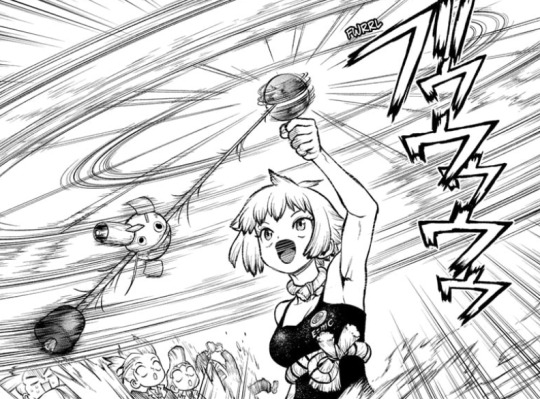
A problem that arises from this, is that if the weight doesn't match the rotation of the earth, the cable would get pulled around (eventually breaking or winding around the earth, pulling the weight down, as cartoony as that is), so we need it to hover over one spot.
Now we gotta talk about geostationary orbit, to make this easier.
So, when something is orbiting the earth, it needs to move really fast to combat gravity in such a way that the earth curves away from the object at the same rate it's falling towards it (spaceflight really is the art of falling to the ground and missing it, as the saying goes.)
The farther out you go, the weaker gravity's pull gets, and the slower the satellite needs to be in order to find this balance. Eventually it reaches the point where, if its flying around the equator, it will, at one point, match the speed of the ground spinning beneath, this is at 35786 km above.
Such a satellite appears still in the sky, which is very handy to, as a sidenote, aim a small TV dish at it, and just leave it in place, as you may have at home.

However one must notice that in a space elevator, the satellite (our weight) is not only pulled by gravity but also by the tension in the cable.
Since it's pulled in with a greater force, it falls faster than a normal satellite, and so it needs to also travel faster to avoid falling back to earth.
As a result, it also needs to be further away than a geostat satellite, so it needs to travel a longer way around the earth, and again find the balance of speed with rotation, staying still in one spot while keeping the cable taut.
This is why the weight is shown beyond geostationary orbit here. Yes, this was a long winded explanation for just that.
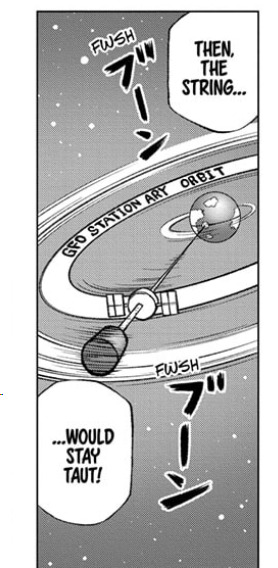
And after all that, here we all are, ignoring the fact that suddenly petrified hair is flexible.
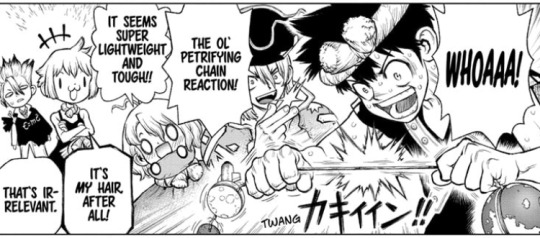
Perhaps it's like glass fiber / glass wool, and it can be flexible when it's thin enough (yes, glass fiber is just glass but thin, if you weren't aware. Incidentally, most glass fiber is made by a process that works the same as a cotton candy machine... wait this was already shown in Dr. Stone, fu-).
This however doesn't explain how this flexibility hasn't been observed in statues before. Maybe her hair is special after all.

Also special is spider silk, although sometimes overhyped by the media. Spider silk has some outstanding mechanical properties, it's very durable, and it can take a lot of tension and deformation before breaking.


Ruri here makes a reference to her previously stated occupation after the main series. A lot of people took issue with the aftermath of the characters in general, myself included. Still mad at Kohaku joining the police, I'm pretending that didn't happen.

This might be an autism 100 take, but the wheels in this cart are backwards. The flanges should be on the inside, and the taper should be towards the outside.
This geometry helps railway wheels stay on the track, go around bends, and not have to constantly abuse the flanges to not fall off the rails.

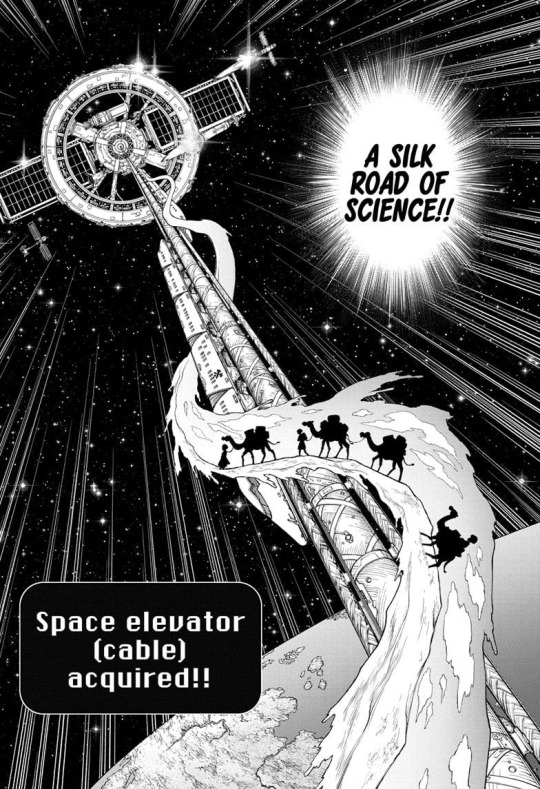
The silk road... I really am just googling basic things for you, am I? It was an ancient trade route network joining asia with the middle east and europe. Silk was one of the most famous products traded through the network.
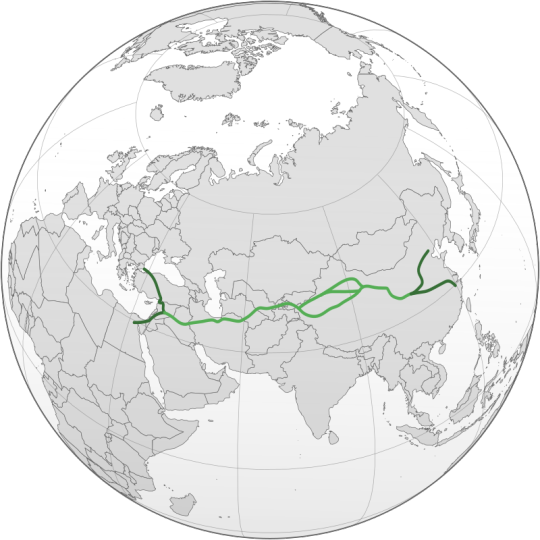
yeesh, I've been typing this for ages (tumblr logged me out while I was writing this post and lost like half of it), and I haven't even gotten to talk about induction motors yet.
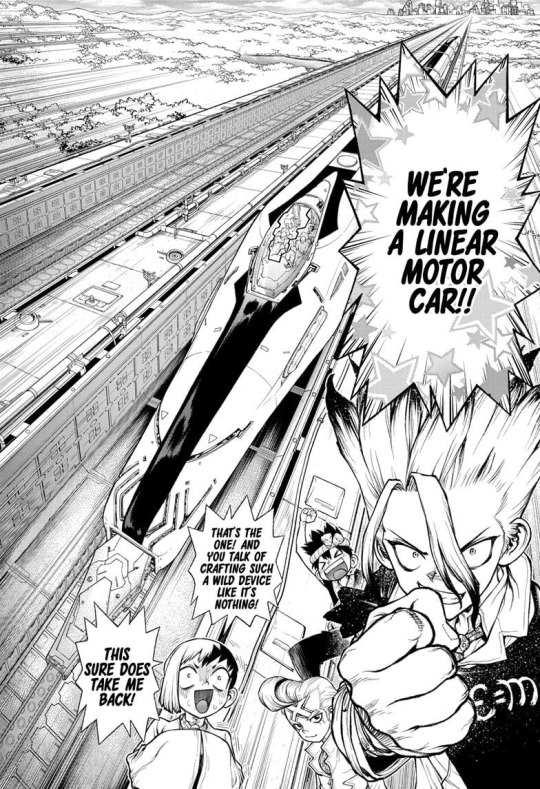
A linear motor is just an electric motor that rather than making something spin, it pulls itself along some sort of guide rail. These are in use in some trains but they are not common, the infrastructure cost is much higher than a normal railway.
Why am I talking about trains again...
One way to make it work is by induction.
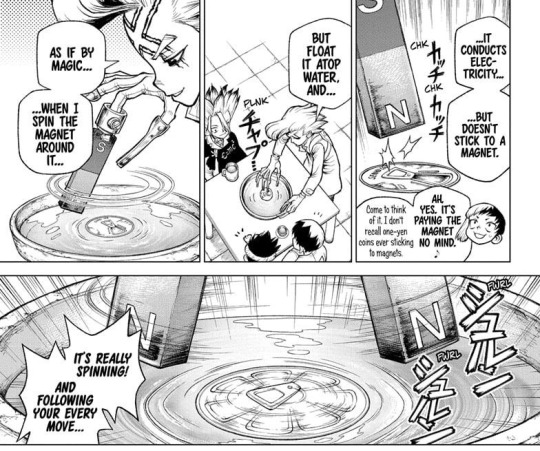
The tl:dr is that when a magnetic field is moving through a conductive object, it can effectively drag it with it to an extent.
The reason this happens is called Lenz's law; the variation of the magnetic field through the metal causes an electric current to flow through it.
This current, just like an electromagnet you may have put together in science class, produces it's own magnetic field that interacts with the one coming from outside, hence making the metal react, but only when the field is moving or otherwise changing.
A big advantage is that there needs to be no contact between the source of the field and the moving metal; this is used in all sorts of electric motors even in homes, you'll find them in fans, refrigerators and washing machines, etc.

The train/motor would have a magnetic field underneath with a north-south-north-south-... pattern, which flows towards the back like a river (made by a lot of electromagnets switching in coordination).
As the magnetic river flows backwards, the induced currents in the rail produce their own magnetic field in opposition, pushing the train forward.
How viable is it to use this on a thin cable that needs to pull itself up is another story, and I have my doubts. The electronics involved would be really complex, costly and perhaps even unwieldy, but at least the conductive cable can also be used to deliver power to the elevator with some tweaks.

The structure they begin constructing for the full size elevator is named after the 1979 novel "The fountains of Paradise" by Arthur C. Clarke, in which a space elevator is also constructed.


So, we've made it to this part. As far as I've seen this one panel has been the focus of like 50% of the discussion regarding this chapter.

We all see what he's doing whether we acknowledge it or not; Inagaki should know that you cannot build a relationship on just standing close and gazing with passion; believe me I checked, multiple times.
Wouldn't mind if he hadn't procrastinated on developing Senku's side, the girl has wanted her vegetables since day two (but not day one)



And now, things get really messy, as some mind boggling events lead Ryusui to ask "why, man?"
Look, I've already added 30 images to this post, and I imagine you have seen how this chapter ends, if you haven't, buddy what the heck are you doing here. Have some emoji, I'm not gonna make a second post about this.
🥨✨🦟 ⁉️👱🏼♂️🏴☠️ 👨🚀☠️??
You may be confused, you should.
But after a while I came to a conclusion that I feel is pretty solid, and you may have seen it in the post from earlier.
To summarize:
Ryusui noted that things were going suspiciously well for them, and the sudden disappearance of mosquitoes in the Kanto region ticked him off to something. He sent people to search and indeed found that mosquitos have been petrified within the region, and questions whyman about it, going as far as accusing them of pretending to be Byakuya from the future.
That's where we are left.
The medusa is fully capable of faking the signal they received from "Byakuya". The receiver only detected bursts of petrification beam presumed to be from the future and decoded them as morse code, and it was noted by Balb on discord that if you trace a circle with the center near Tokyo (where the lab keeping whyman is) and a radius reaching as far as Fuji, where they received the message, the circle covers the majority of the Kanto region as stated.
The bursts of petrification would have been invisible to humans, as only the affected species can see them.
So it is assumed that the mosquitos were petrified as a means for whyman to send the fake signal all the way to Fuji, depleting its diamond battery in the process.
However I believe it's also possible the mosquitos were zapped later to make work easier for the people building the space elevator as noted by Kaseki.
Several months if not more must have passed since the Byakuya message and whyman being caught (enough for Kohaku's hair to regrow), and it would be odd that no one would have noticed the lack of mosquitos, their petrified bodies, or the effect their absense would have in the ecosystem.
So why do any or all of this?
Well we know what whyman is largely motivated by, its survival and the spread of its kind across the universe.
So I think it's trying to accelerate human progress for that purpose, so we eventually get to the point where more medusas can be made, or who knows, maybe even succeed in warning the past ones with the time machine.
I also think it's likely this misunderstanding is gonna fizzle out once some dialog is made and Senku basically says yes to that goal too.
Will we get a triple twist and find that the Byakuya message was real after all, and the mosquitos were a separate event?
Will the sengen and kohasen crowds envelop the world in thermonuclear hellfire?
And will this be the true final end of Dr. Stone? hard to tell, but the answers may come next week.
Goodnight.
#dr. stone trivia#4D Science#dcst#Dr. Stone 2D#dr stone#dr. stone#drstone#dcst senku#byakuya ishigami#dr stone senku#senku dr stone#senku ishigami#dcst kohaku#dr stone kohaku#kohaku dr stone#dcst suika#dr stone suika#suika dr stone#dcst gen#dr stone gen#gen dr stone#dcst chrome#dr stone chrome#chrome dr stone#dcst kaseki#dr stone kaseki#kaseki dr stone#dcst ryusui#dr stone ryusui#ryusui dr stone
68 notes
·
View notes
Note
Hi! Welcome to Tumblr!!!
My question is - do you have a favourite star or constellation (or other celestial body)?
But . . . I really hope that at some point you will consider explaining a bit about the different types of orbit (low earth orbit, geostationary, polar . . .etc).
Thanks!!
Thank you for the welcome :) I have to admit it is... nice to have a new way to connect with people on my downtime.
A favourite star or constellation... Of course, if we were to consider all the celestial bodies I wouldn't have the time to discuss them all. So many fascinating examples of astronomy, with so much to teach us about our universe.
It's odd then, how stars get tied so closely to stories, and to home. It was Scott who taught me to find north using the stars, a new badge on his scout uniform. Dad told me about how stars look different in space, how the atmosphere creates ripples in their light, and I remember how badly I wanted to see it for myself. And it was Mom who told me the stories that could be found in the constellations. She collected them, told them to us to lull us to sleep.
My favourite was her version of Capricornus. She told me that it told the story of the father of the sea-goats, Pricus. His children were curious, wanting to explore the world, and more importantly the land. But Pricus knew that to explore the land meant the tails that helped them swim in the sea would be sacrificed and they would be separated from him forever. He had the power over time, and turned back the clock again and again, drawing his children near every time they came too close to the shore. When he eventually came to understand he couldn't keep his children safe and close by forever, he asked Chronos to make him mortal so he could mourn the loss of his children but not endure it forever. Instead, Chronos set him in the sky, where he could watch over his children from afar.
Mom used to say that's what Dad was doing on his trips, watching us from afar.
Capricornus was always my favourite because of that. Nowadays, I know I can't turn back time and keep her close anymore than Pricus could. But if she's watching over me, it'd be with him.

Oh and EOS is badgering me to say she likes Scorpius best.
Further reading:
https://www.universetoday.com/19825/constellation-capricornus/
https://greekgodsandgoddesses.net/gods/pricus/
#bri comment: there were so many myths associated with capricornus.... but I like this one :)#bri comment: it suits the vibe of the story i'm painting#tb5 responds#tb5 astronomy
9 notes
·
View notes
Note
[You have received reports of a Sevcon Orbital Mining Strike Machine in geostationary orbit.
It seems to be aimed directly at the spot where Alternate Cedar and the rest of the Sevcon encampment was.
Which after thorough investigation, has anomalous energies coming from below it.
Something is in the mountains.
And Sevcon wants it. Whatever it is.]
SHIELDS FULL POWER. ACTIVATE GROUND TO ORBIT WEAPONRY.
SHOOT THAT THING OUT OF THE DAMNED SKY.
And proceed with the extraction of whatever sevcon wants here.
Essentially, a "forest" begins to start glowing. Trunks shifting position as the shell is shed and barrels begin loading up high power titanium bolts. Hundreds of railguns.
The boom knocks out windows for miles
10 notes
·
View notes
Text
Ok SO I’m taking some orbital mechanics and aerospace classes right now and we’re learning about different orbits and what they’re used for. Low earth orbit is generally used for observation satellites, medium earth for navigation, and geostationary is where a lot of the broadcasting satellites are. As previously mentioned, I am experiencing terminal levels of Mad Max Brainrot.
SO:
With the Vuvalini, when they see the satellite, it is moving. Geostationary broadcast satellites, like the ones that would be broadcasting the shows, don’t appear to move in the sky. You know what does? Lower earth orbit observation satellites. You know what’s also in low earth orbit? The ISS. That could very well have been a tin can full of corpses they were reminiscing at.
#did this make any sense to anyone but me#the only way I’m getting through this class is by associating it with my current fixation#mmfr#mad max fury road
13 notes
·
View notes
Text
静止軌道上空のあなたへ | cosmomule
#cosmomule#静止軌道上空のあなたへ#to you on geostationary orbit#my post#musik#one of the best things ive heard in a while#cosmomules EPs are incredible along with everything else he's been a part of
2 notes
·
View notes
Text
FERMI PARADOX #2
The only thing worse than losing, is losing you. [ iskandar x reader ]
The Sword of Damocles splits bladewise—flowers out, needle-petals fractalising—lacerating black space with composite white alloy. It’s almost chimeric, chthonic; like an organism crystallising, expanding itself beyond comprehension. Babylon was barely an upgrade from the ISS, let alone the Tiangong. It could never hope to do something like this.
You ogle at the Sword from far behind the viewport. Next to you is Iskandar, linked up to his psychokinetic command frame, feelers rippling with incandescence as they worm deep into the frame’s exposed indents. Solomon stands solemn on Iskandar’s other side, a flotilla of Oracle devices hovering in his hands, their throughputs almost kinetic. He handles data like an experienced statistician, unperturbed by the daunting volume of inputs in need of quantitative analysis and yet, keenly aware than any mistake, no matter how minor, would come at a debilitating cost. To them—Iskandar and Solomon—a command is just a calculation, numeric and numbingly abstract. To you, it is a blood debt with every set edict.
The Sword of Damocles is a geostationary orbital platform. By definition, it should be enslaved to its planet, like all good satellites are. But you shouldn’t presume such simplistic notions of what should and should not be. In the Sword’s wake trawls the green mistworld, dragged along as if it were a leashed dog—a defeated, domesticated thing. The Oracles move planets. Is that not the work of creation deities? Or are they it? Are they the ones that made you, left you, only to return as divine punishment for mankind’s sin of many greeds? Apex of your planet, sure, but not of the galaxy. A great filter that is rank wars with higher-type civilisations. It’s so depressing: the outlook on survival.
The Sword is like a blender. The mum you used to have—she in turn used to have one of those. You still remember how some days, after school, she’d sit you down by the kitchen counter as she homogenised the worst possible combinations of health foods, then forced you to ingest them. It’s good for you, she’d say, eat up and grow strong now. The Sword slurps up a tendril of mist from the green planet’s atmosphere and pipes it down the guiding line of the central taper. The rotary razors control the outermost wisps of the vortex—tame a fabricated storm. You’re not sure what it’s doing. Charging a superweapon, probably. All you can really think of is how much you miss your mum’s shitty kale juice.
In your periphery, you notice the flexion of Iskandar’s claws. He must relish this opportunity of wild abandon, of total war. His ship buzzes with the excitement of astral artillery. The hydraulic hiss of conventional projectiles loading into propulsion chambers. Particle beams powering online. Forcefield generators humming low and lecherous, readying for a pounding. Warfare and fanfare aren’t so different. This is a sort of music. A marching beat. Drumming. Reckoning.
Iskandar’s aural threads pulsate as they probe into the rhombus frame around him. It saps away at him, at whatever he’s secreting. His focus is undivided on the objective—his sole obsession, conquest. You are thrust back to a memory of Aegis. His ripped, rippling war banner, bleeding into the sky the colours of the human coalitions that had yet to mature into the Federation. The victory and valour of the Halfmoon Resistance. His heromaking. You’ve only heard stories of it, broadcasted re-enactments engineered for morale boosting. You’ve never really asked. But you just know what he must’ve looked like then, standing atop the enormity of his achievement.
Like Iskandar. He looked like this alien beast. Dauntless General, indomitable God of War—Enyalios Ares. Who could cut down a figure who stands like that? Like worlds are at his fingertips. Like he is already statue, already the image of legendary. It almost makes you wish Iskandar was on your side. His confidence is a casual one, as if victory is already assured, and he only fights for the fun of it. This is his element, his calling. Bear witness to genius, to greatness, to destiny. If only you weren’t fated enemies. You would have worshipped him.
Iskandar raises an arm. A formation of vanguard starfighters fly along the arc of his movement. Crest like a comet tail into the endless night of the cosmos. You recognise models and flight divisions—the industrial patterns of their ecological biases and the structural orthodoxy of Oracle military theory. Stellated drones that whirl over assault ships like halos. Interceptors in couplets, triplets, common time and andante tempo. In one moment, they are interlinking. In the next, they fissure, all to discombobulate enemy radars and thermal trace. You remember the frustration of facing this tactic—aberrating formations—and so you observe keenly as Iskandar orchestrates his resources with a control inherently surgical, dismantling the incoming barrages as if they already came in loose. He reads chaos like a manual, with nothing escaping his grasp.
The laser rounds exchanged shine brighter than stars. Usually, the guns of a starship are like thunder. Back when you were still on Earth, still reeling from the aftermath of zero day, the Federation happened to have been testing their prototypes near your sanctuary settlement. You remember hearing the flyby, the guttural roar of supercruise, the deeply mechanical opera of energised cannons. They screeched like an incoming catastrophe, and to be hit by anything like pulsefire or plasmatic matter would be exactly that—catastrophic. You’ve seen Oracle beams corrode through human starfighters, sweep entire squadrons away like a windshield wiper across the dashboard of space. It’s horrifying. And it’s silent. All of it. Muted out there in the dark.
Effortless. That’s how their technology looks. And that’s how Iskandar makes manipulating the playing field seem, sectioning away entire cuts of the battleplane for himself, pushing for aggressive strategic positions. He’s never behaved like this in your goofy ahh matches. Serious, yeah he’s always so serious, but bloodthirsty? No. He plays safe and defensive against you, always. As if he knows you can’t handle more than that. You’re a child frolicking at his feet. Watching his true prowess on display is sobering. He goes easy on you, and even then, you struggle.
So your shame-addled mind tries to find faults. He’s pushing the wrong quadrants, he’ll get pincered, he’ll lose the momentum. It’s as if Xerxes is reading your mind, and Iskandar, reading his. It becomes a farce, a counter-offensive, a lure into an envelopment. Iskandar rides out on Xerxes’ tides and stabs his forces with a guerrilla enkulette—assassin interceptors blinking out of the astronautical swarm. It’s Xerxes that pushes too far, one man’s greed provoked by the illusion of another’s. And Solomon’s watching this all go down with his usual deadpan, like he’s watching the weather, and the day’s particularly sunny and boring.
Xerxes isn’t a fool, though. He understands the rhythm. The deeper you go, the more you are stretched thin, and the enemy’s threat potential increases. So he doesn’t penetrate more than necessary. The two armadas meet like mesh. The frontline fluctuates like a coastline. Iskandar is happy to play this way too, a more attrition-styled confrontation. It’s your preferred style as well, so he has the practice.
You know that when he takes down one of Xerxes’ discus-shaped heavies, it’s like flicking a bishop off the chessboard, a relief—one step nearer to victory. Iskandar is picky with what he wants to kill. Picky but deliberate. You dislike watching this from Iskandar’s side, just as much as you dislike being on the receiving end of a slow but certain defeat, with the impassive Iskandar leering from the opposition bridge. It’s clear that the current you can’t go up against Iskandar in an actual firefight. You’d be annihilated, and unlike Xerxes, you won’t have even been able to put up a decent resistance. So you analyse the battle desperately, hoping to gain any mystical insight into what Xerxes and Iskandar’s weaknesses are. Xerxes is brash and showy, but good at recovery. Iskandar is more impervious to being assessed. You only know that he likes to be in control, and you’ve never seen him without it.
But grand strategy is only a part of the greater picture.
Explosions bloom like popcorn in a microwave, the viewport your Faraday cage. You observe alien starfighters performing slick dogfighting manoeuvres and wonder how they’d fare up against Vega or Antares. Probably excellently. Lightning crackles inside the plumes of the Sword’s storm. Heavy cruisers move forward sluggishly, fat with ordnance and more importantly, a panoply of shielding technology.
A sudden impact rocks the warship off-kilter, slurring it at an angle far too steep for standing. Before you can slip away, Iskandar grabs your arm, steadying and securing you against his chest. He is firmer than steel with all that armour, so when he ‘hugs’ you like this, it’s unbearably uncomfortable. Still, Iskandar’s focus is screwed ahead on his battalions. Nothing can shake him, and nothing should.
Solomon makes an annoyed noise. He’s managed to latch himself onto Iskandar’s throne, but all his calculation implements have been knocked away. The white Oracle trills something, maybe a snark remark, though you’re not even sure if he’s capable of such sass. Iskandar doesn’t provide a verbal response. Instead, his tentacle stubs burn paler, flaring with sheer power. The ship responds to him, correcting its slant.
Solomon groans softly as he fixes his posture. His destitute red eyes meet yours accidentally. Your breath hitches as he draws nearer, placing a palm against your cheek. His stare intensifies, diamond pupils dilating as he scours you for injuries. When he finds no such thing, he murmurs something again to Iskandar, then pulls away entirely from the two of you. Iskandar keeps you in place for a moment, as if anticipating another impact. But you must’ve mistaken his courtesy, because he lets you go soon after—almost too quickly, bulky arms falling away as he comes to his senses—and coos for you to go with Solomon.
You don’t protest. Iskandar sheds his dispassionate concern for you and resumes his post, commandeering a skein of interceptors to recall. They soar over the viewport in a V formation and sweep the ship for the collision source. Solomon leads you away, off the command platform and through the deactivating power field of a gateway. The ship's halls, in comparison to the control room, are hectic. Jam-packed with Oracles running amok, managing chains of supply and command, suffusing trickle-down orders. A klaxon is blaring. Waves of deep ultramarine light run down the hallway between momentary blackouts, moving like the contractions of intestinal lining. You no longer have access to the viewport and what it lets you see. It makes you anxious—this blindness.
“What hit the ship?” You ask Solomon aimlessly, keeping pace with him. Iskandar tends to banish you out of worry. He’s only a fool when it comes to matters concerning you. So whatever it is, it must be critical. You can’t even figure out how something could hit this warship in the first place, so safely tucked away behind Iskandar’s main forces. The only crazy-long-ranged possibly-ballista you’d seen was the ominous gestations of the Sword of Damocles.
Solomon pauses mid-movement, expression grim and suddenly alert, seemingly trying to sense what’s going on outside the ship.
The answer comes to you.
A hole is torn through the inner wall, metal melting away like petals withering. Smoke above and magma below—puke out from the newborn cavity. The air seethes hot and blurs everything. Your hair singes, cheeks sunburning. A crushing pressure is felt before the entrance.
In steps one leg. Then another. Black armour, shining knightly yet draconically scorched. A clawed hand rakes into the molten edge of the wall, deforming the softened structural material as if it were no better than putty. It pulls a horrific thing into view—a malevolent entity that gets all the Oracles around you scrambling to flee.
You named him Subutai. Where he walks, destruction follows. Death trailing. Even now, on sight, your neck burns up. The Mongols pillaged women and ravaged them, ruined their dignity, introduced them to savage depravity. Your fate was no more fortunate. A prize that was used for pleasure and then left broken. You can’t even gulp down the panic. Your throat is in flames. Your own blood chokes you, boils out of your body. Are you dead yet? You blink. You hate how he makes you hallucinatory—depriving you of self-control.
Subutai stands to his full height, hand leaving the wall. His armour seethes, steam dissipating backwards in thin, translucent strings; overheated air offloading excess power from the body. There’s no flaw in the design. It is evil. He is evil. That armour is made of human nightmares.
Solomon has a disgruntled look on his face. But he doesn’t say anything. Even he knows that it’d be a waste of time to talk to this natural disaster. Solomon can’t save you. No one can. So you must resolve this by yourself—with a skill the Oracles lack—with diplomacy.
You take one weak baby-step towards Subutai’s far more imposing form, exuding bloodlust and heatwaves. He would’ve had to slaughter through Iskandar’s elite ranks to have reached here. The tension that thrums in him is evidence enough of it. He’s amped with berserker madness. Twitchy. Tipping into a psychology that terrifies you—a craving for mindless violence. You don’t feel like a diplomat anymore. You feel like an EOD specialist risking your life to defuse a ticking time bomb.
Subutai reaches out for you and you flinch. You almost think it’s your neck again that’s going to get wrung, but no, he touches your chin instead, grips it between his fingers with all the manner of a brute. A low and pleased growl thrums from his throat. He yanks you closer and you stumble, nerves ablaze with phantom pain. It’s a little better that you can’t see his eyes. They’re truly the worst part about him.
Solomon finally finds his voice, thinking it due time for a comment. Whatever he says, it’s something less succinct than his usual noises, and so you figure that he must be chastising Subutai. Subutai whacks your shoulder to get you moving—branding a handprint for sure—and mock-salutes Solomon as a response, sparing him nothing else. It’s almost a funny sight, the excessively intimidating Subutai deferring to your very much nonthreatening Solomon. Except you want to cry instead of laugh.
You are forced through the smouldering wreck of Subutai’s warpath. He doesn’t even need a weapon to get you to behave. He is the weapon. You trudge through the ruins of rooms you recognise, once so sanitary and spacious. Now they form a collapsed complex, everything obliterated and swallowed by inferno. At the centre of the shattered site is Subutai’s starfighter, gleaming in wait.
It’s remarkable. All Oracle ships are, but his is idiosyncratic. Like nothing you’ve ever seen before. Most human starfighters are shaped like arrowheads or spearheads, sharp and aerodynamic as influenced by aeronautical engineering accounting for atmosphere. Oracle starfighters are polygonal in all sorts of ways, enigmatic in their schematic intent. But this is unprecedented. Subutai’s ship grooves. It has curvature. It has circular motifs all over. There exists an Oracle shipwright out there who thinks outside of boxes. Thinks like an alien to their own kind.
The fighter reminds you of a nautilus, with a heavy spaceframe shell and a conical cockpit. The shell part is covered with thrusters, all shaped like volcanic craters and periodically placed like warts. You’ve seen twinjets, trijets, but not whatever this bullshit is. This mustn’t be for speed or power, but manoeuvrability. A jet engine for every possible vector. Omnidirectional movement. Oh, Sirius would have loved this.
Your fists clench in unwittingly. As Subutai brushes past you, your gaze falls onto his back.
A superluminal thrust of a lance. An eternity of red. Your heart squeezes itself inside your ribcage and you mumble incoherent mantras to yourself. The lower hull of the cockpit unhinges itself and drools out a ramp. Subutai makes a high-pitched kettle whistle and props one leg up on the ramp. He’s half-turned to you, anticipating your next move.
Unfortunately for him, you aren’t stupid. If you run you’ll just become a bloodstain. So, as an exemplary hostage, you ascend the ramp, shuffling inside the small cockpit. There’s barely any room in here, and there’s only one seat. Right. Obviously there’s only one seat.
“Where do—”
The ramp curls away and the lower hull fixes itself again, sealing the two of you in. Subutai moves like a viper, yanking you onto his lap. His claws flutter over your thigh and then cramp into flesh, keeping you trapped against him. You don’t dare to move. There’s barely space for that. But the last time he was this close...
You’re hyperventilating. Not that Subutai seems to care. He doesn’t bother to be gentle—gets even more brusque, actually; working over you to interact with the fighter’s controls. You want to scream. He burns.
A low pulse echoes. Belches a frequency so heavily bass, it almost recalibrates your heartbeat. Several barnacle-jets burn out, firing up for take-off. The fighter tremors and you shrink in on yourself. Subutai takes the opportunity to ease over you again, toggling a few modules on the HUD. It’s a glassy, holographic, and utterly alien interface, but you recognise floating snippets of Oracle logography. You’ve always envisioned Subutai as a monstrous soldier, so this meticulousness on his part is jarring—is he actually a good pilot too? You suppose you’re about to find out.
Launching is always the worst. You are lurched back, pushed into Subutai in the most sickeningly intimate way, squished between all his limbs. He lets you brace against him, unwillingly snug, mostly focused on ramming through the rest of Iskandar’s warship. The nose of the fighter is sharp enough to puncture through all the innards. When you see the black of space again, it’s with the glitter of dead Oracle bodies and debris, tumbling after Subutai’s momentum like spindrift. The warship heals its wounds quickly, power fields sealing the holes.
Subutai wastes no time to correct his trajectory, veering your sight to the Sword of Damocles. To get there, he’s going to have cross the entire battleplane. You don’t think it’s possible. You think you’ll be dying today, with all the menacing barrels and coils pointed your way.
Iskandar’s interceptors surf over the surface of the warship like darting fish, honing in on Subutai’s fighter. They move with supple grace. Subutai does not. Different jets blast alive, with that same low growl rumbling in your ears. His fighter moves like a dragonfly, with a precision like nothing you’ve ever seen or felt. You’re whipped from one of Subutai’s arms to another as he makes a mockery of the interceptors, moving like zig-zagging electricity; throwing them so utterly off that they collide and die against each other.
A light that’s almost divine cleaves the space right in front of your eyes. Subutai dodges diagonally, giving you a rather cinematic pan of the thick electromagnetic rail. If that had hit, you’d have been incinerated in an instant. A pretty good death, all things considered. The HUD overlay indicates that the attack came from Iskandar’s warship. Subutai makes a musical sound—a cackle, maybe?—enjoying the special attention.
He turns his fighter to face the capital flagship of his enemy. You see the viewport of the command bridge, where you had been only moments ago. It’s impossible to make out any details with the tint and distance, but you know that Iskandar is there. And he had ordered that attack. Your heart’s thrumming so hard you fear you might vomit it up. So this is what it’s like to face him. Every move is evading check; he keeps you one mistake away from mating so that you can only focus on survival, and not winning.
And this insane bastard Subutai enjoys the prey game. He’s only ever alive when he’s killing something, but getting killed? That seems to stimulate him too. Gets his body hot like a fission reactor, fusion tokamak. You clutch yourself tightly.
All this time fuelling yourself on spite and hatred, you’ve forgotten that the Oracles sparing you was a mercy. Even now, you are weak. You want yourself alive more than you want them dead.
Subutai hurdles away from Iskandar’s ship. And so it begins: the arduous journey back to the Sword of Damocles.
Three assault ships come in from the left flank and fire away. Subutai barrel rolls and shirks their streams of attack. He hasn’t used his weapons systems once, and even now, he doesn’t bother. Why waste munitions when he can just dance circles around his pursuers? It sucks for you, because you’re getting nauseous from all the irregular motion.
The assault ships split away as soon as he’s moved out of their sphere of control. But it’s far from over. The fighter’s radar pulses. A lot of jittery signals are being detected behind him. Subutai twirls around and you two see it: a tailwind of drones, hundreds of them, perhaps even a thousand. Drones might not have firepower, but their numbers alone would pollute the area, rendering Subutai’s superior manoeuvrability invalid. Your life is currently in Subutai’s hands. Although you loathe him, you also need him to win against Iskandar. Otherwise you both die and fuck, fuck, you’d rather die alone than with Subutai.
Subutai doesn’t seem very impressed. With renewed vigour, the HUD shimmers out fragments of a fresh interface. You don’t sense anything, not even the release. But you see it. It reminds you of white phosphorus—countless ropes of white snaking in every direction, unleashing anarchy. This medusa missile barrage crashes into the drone swarm and connects. It’s like a summer of locusts meeting a timelapse of an expanding fungal network. Both sides are innumerable. And perfectly, they annihilate each other.
There’s a beauty in the destruction that both you and Subutai savour. The silence of the violence, the stunning realisation that there’s a chance after all—that Iskandar will eat a loss today. But the nice feeling doesn’t last long. A warning pings on the HUD. Something’s in rapid approach.
The radar becomes periscopic and reveals the threat. It’s a ship with six wings, seraphic. It moves faster than gunfire and only slightly slower than lightspeed. In a blink, and it’s almost kissed Subutai’s fighter. But it twists in the last moment, gliding a close pass, cockpits an inch away from scraping. You see the Oracle inside it—a black one. Their helm tilts up, as if appraising you and Subutai mid-pass, completely unbothered by the unnerving proximity.
Iskandar’s really not letting up. Why’s he sending this ace against you? There can only be one reason. Your blood ices. You try and crane back, to look at Subutai again, but he jostles you as soon as he feels your movement, knocking you back in place.
This is going to be a bout between champions.
Subutai’s opponent flies like a fighter from Strikeforce Draco, General Aegis’ personal elite unit. Each and everyone of those pilots served in the Halfmoon Resistance. They are nothing short of spectacular—you’ve seen their mock engagements and sorties from Babylon’s viewport, and can only imagine how they fought during the Resistance.
Eltanin’s the flight captain of Draco. You’ve never spoken to him before, but you’ve seen him in action. The number of people who’ve been able to defeat Eltanin in the sims can be counted on one hand. His handling is nothing short of immaculate. No extraneous flair. Every motion, purposeful. An elegant, emotionless pilot who cannot be stirred into mistakes, and thus, can only be trounced through superior skill.
So it comes down to whether or not Subutai has the superior skill. Eltanin’s mirage, this opponent of Subutai’s, moves quick and quiet, forcing Subutai to act on instinct. You’ve always thought Subutai to be a trump card for air-to-station assaults—someone sent into a siege after astral superiority is secured. Such a soldier wouldn’t be level-headed enough to be a pilot. But Subutai proves you wrong, because being level-headed wouldn’t help anyone survive in this situation. His primal barbarity makes him the threat and keeps his opponent on their toes.
The enemy fighter circles back, the arc of the manoeuvre giving you a good look at their gorgeous black spaceframe. Subutai readies himself by finally taking all of this seriously. His HUD bursts out, systems now fully active.
You would’ve loved to watch this showdown if it weren’t for the fact that you were right here in the middle of it.
“I don’t care if you’re bringing me to Xerxes, just in one piece please! One piece—!”
Subutai’s taloned gauntlet slams over your mouth and he makes a deep rumbling noise, probably telling you to shut up to whatever crude equivalent the Oracle language has. Several of the barnacle-jets burn, yet you cannot guess where Subutai will move next. Such is the nature of his fighter.
The enemy fighter slices closer and closer. Subutai stalls in place. You can feel him rolling his neck from behind you, as if to say “bring it”. And sure, he might have the balls to standoff like this but you don’t. Through his muffling hand, you bleat deformed chants of panic. His grip is powerful enough to mince through your cheeks. Just as your head is about to pop, he lets go.
The enemy fighter opens fire, laser bolts spluttering out in an indiscriminate hailstorm. Subutai pulls away, different thrusters hissing on and off, pinballing his fighter in a frenzy of directions. He loops around the volley with dizzying acrobatics, and though the enemy tries to track him, they don’t land a single hit.
Subutai is raving away, mad with excitement. He manages to execute an inverting flip over the enemy fighter and unleashes a fan of beams, which move to converge on the targeting point. The enemy fighter weaves away deftly and wrests for their control back. You are groaning now, unable to stay conscious with the high g-forces throttling you. Subutai flies like a wild animal. Fittingly juxtaposing his enemy.
They’re overextending—Iskandar’s pilot, that is. This is a foolish skirmish and you don’t understand why they or Iskandar would want this. Hubris is no folly of the black general’s. And despite the clear danger Subutai’s existence poses, it still wouldn’t warrant this reckless pursuit. You’re not going to believe that Iskandar is saving you, either. Because if he were, he wouldn’t be using deadly force. It’s baffling, and in the heat of things, with your fear amped and anxiety spiralling, you can’t help but want to puzzle Iskandar’s rationale.
An array of interceptors soar in from Xerxes’ side to assist Subutai, who roars out with rage, firing warning shots at his own friendlies. To ward them away, perhaps? So that he can have this glorious moment to himself. You have no way to calculate your chances of survival because Subutai is crazy. But Subutai needn’t have worried. The enemy fighter does a smooth pivot, a locking twist, and shoots itself towards the interceptors.
It cuts through them. A gleam shines before they all ripple into smithereens.
“What the hell?” Your words slip through winces. You’ve never seen a fighter do that. Take down enemies as if it were a melee weapon.
It realigns itself, and with a no-longer-surprising burst of hypersonic speed, charges at Subutai. Subutai’s helm tilts down. He prods your cheek with the side of his head, as if taunting to you observe what’ll happen next.
The enemy fighter closes in again. Your ears shatter with the sound of all the barnacle-jets spewing fire. The enemy diverts just in time to avoid being instantly deep-fried. Two of its sharp wings extend out and detach, dropping into the battleplane as separate semi-autonomous problems for Subutai. They fire beams that lasso around and herd Subutai into uncomfortable positions. You don’t want to see what it’ll be like if the other four wingbits detach too.
Subutai is determined to get close to the enemy fighter, as it’s the only place he’s safe—the wingbits won’t fire at their controller. The confrontation becomes medieval, with each fighter’s forcefield fizzling against the other’s as they smash together. Subutai is rabid, he gives chase like a hound. You don’t understand how they remain lucid enough despite pushing the limits of physics. But then again, you don’t understand how Eltanin or Antares do it either. This is simply not your expertise, and it never will be.
The entire battleplane goes white. You squeeze your eyes shut but it still doesn’t prevent the light from bleeding through your eyelids. When it dies down, you open your eyes again and look around. The line of heavy cruisers that formed on Iskandar’s command have placed up a giant screen of a forcefield. Against it struggles living lightning. The way it crackles over the merged forcefields is feral, and the way it endures, the way it searches tirelessly for a way to break through—it makes you wonder how you’d defend against such a raw weapon of might.
Your gaze veers over to the Sword of Damocles. The outer razors have stopped rotating. Lightning winks between them, a lingering proof that it was indeed the Sword that issued the celestially-proportioned strike. The forcefields of the heavy cruisers start to fracture, disintegrating in tiny patches and then, all at once.
But the concentrated lightning had only been the first step of a sequence. The Sword’s razors flex out to make way. The storm that was being harnessed from the green planet is now leeching out. And that’s when you see it: the slithering skin of a giant worm.
Xerxes is firing the worm. It’ll eat through Iskandar’s heavy cruisers and the rest of his forces with the cruiser shields down. You unconsciously suck in a short breath.
Subutai scoffs like a locomotive blowing steam and resumes his fight. The enemy, equally unbothered, clashes back. Your body rattles at the impact. They must want Subutai’s head really badly if they’re willing to push with foolish aggression like this. Subutai’s claws flex as they run down the streams of his control terminal. He seems to be getting more impatient. You can tell he hates it—playing defensively, ironically for you all of people.
It becomes too much. You pass out. The last thing you hear is high-pitched air, residue of Xerxes’ lightning.
When you wake up again, you’re in someone’s lap. Fingers pinch your hair and rub the strands together. It’s blurry and so you can’t tell who it is, but their gentleness is comforting. You haven’t known gentleness since the Oracles shredded up your moon. Then the image becomes clearer. An armour that’s fancy like Iskandar’s, but white. It’s Xerxes.
You stiffen, but otherwise make no movement. This is the closest he’s ever been to you. You’re in his lap and he’s fondling you like a kitten, mesmerised by the novelty of a human, perhaps. He’s seated on his command throne, which is a lot more throne-like than Iskandar’s, by the virtue of it actually being sittable. Xerxes’ tentacles are a pure silver. Pearls of light traverse along them, between his body and the frame.
Now that your eyes are open, he draws his hand away from your hair. Although you’re terrified, you’re also grateful that it’s not Subutai. Xerxes drones over you like a tuning orchestra, speaking in futility. His vibrations reach deep into your bones. His presence, far more imposing than any other Oracle you know. But it’s not a scary kind of imposing. It’s ethereal, almost. You wonder what he wants with you.
Outside the Sword’s command viewport, you see a giant worm. It floats lifeless and in several pieces, copper-blue blood spilling into the cosmos, milky nebula gore. It’s more mutilated than necessary. You say this without knowing much about its specific anatomy, but with a very keen sense of how precise wounds can kill more effectively than butchering. And that corpse? It’s definitely butchered.
“Who won?” You murmur, exhausted despite just having woken up.
Xerxes sings something. You have no idea what though.
There’s a commotion outside. A shockwave rattles throughout the whole room, tingling up your spine and hitting your skull. It comes from the door, which is beginning to warp; first a bruising red, then orange, then brilliant gold. Finally, it burps, liquefied metal splattering into Xerxes’ sanctum and cooling against the floor.
An inflorescence of golden feelers shrivel away, noodling back under crevices of dark armour. Iskandar stands before Xerxes as audience. His fists are balled up, and his legs apart, so even from beneath Xerxes, he seems the more impressive of the two. His cape flutters as he marches in, each step an earthquake. Behind him, on the left, is Solomon, masked with apathy. His eyes don’t meet Xerxes, and so, they don’t meet you. On Iskandar’s right is Boudica. She’s got her helmet pressed between an arm and hip. You recognise it. The enemy fighter against Subutai.
Speaking of Subutai, he here’s too. Following behind Solomon, eyes now visible and ablaze and locked onto you the way a falcon’s would in a hunt.
Xerxes makes a noise. You think you might know what he’s saying. “Why can’t you use the door like a normal person, Iskandar?” Instinctively, you curl closer to Xerxes, because Iskandar isn’t really the image of pleasant right now. You fret that you’ve done something to anger him, because he’s emanating murderous intent that’s somehow worse than Subutai’s.
He ascends the ramp with a slow yet thunderous pace. Finally, he reaches Xerxes’ command throne. Doesn’t bother to salute or bow or whatever Oracles are meant to do. Just stands there. Waiting.
You are thankful that he has the restraint not to pulverise you here and now.
Xerxes says something in greeting, then motions over your head, stroking your hair. You cower under his touch.
A rod of pure energy punches right through the throne, skewering a scorch mark across Xerxes’ cheek. Iskandar’s claws flutter over the rod, which fizzles to stay materialised. Xerxes stills. Subutai has taken a step forward, his lance flaring, but Solomon’s arm blocks him from moving any more.
Xerxes tilts his head to put some distance between him and the near-fatal attack. He makes a glittery remark, which doesn’t prompt Iskandar to move. Not one bit.
Finally, Iskandar speaks. He lets go of the rod and it fizzles out. The wound in the command throne sputters. Towering before the white Oracle, Iskandar’s shadow drapes over the both of you. You feel small and you’re sure that Xerxes must too.
You think you might know who won the wargame.
You move your legs. Xerxes remains still as you struggle to get off him. Standing on your feet doesn’t feel good. You’re swaying but you refuse to collapse. After you get up, Xerxes does too. You’re sandwiched between the two imperators, who are so focused on judging one another, it makes you feel ornamental to this entire situation.
Stepping to the side, you cast your gaze to three Oracles that have been permitted to follow Iskandar into Xerxes’ chamber. Subutai smirks triumphantly at you, then at Boudica, who ignores him in an excellent show of discipline. You find yourself loathing the both of them. Without their fearsome starfighters, they seem a bit more killable now. Just a tiny bit more.
Solomon. You almost want to call out your name for him. His eyes flick from you to Iskandar, as if clueing you in on what you should be focusing on. You divert your attention back to Iskandar and Xerxes. They haven’t spoken a sound, and instead, are just standing ominously, as if communicating through aura alone.
Then, Iskandar draws you into him, his cape fluttering around you and his claw, caging your arm. Xerxes makes an amused noise. It’s almost like a laugh. And so you realise, Xerxes isn’t really like Iskandar. Iskandar practices warcraft. Xerxes seems to enjoy politics more. A poor matchup for Xerxes in a wargame, but perhaps what he sought wasn’t really victory. It might’ve been leverage.
You and Xerxes do share one thing in common: you want to know Iskandar’s weaknesses.
You begin to move, feeling that whatever Iskandar wanted in this interaction, he’s already gotten. But before you can make it even a step forward, you are swept off your feet. You squeal. Iskandar’s arms buckle under your back and legs. He cups you against him—humiliates you in front of everyone.
Xerxes leans back into his throne, cheek resting on bent fingers as he watches Iskandar carry you away. Boudica straightens into a salute and lowers her gaze. Solomon’s expression is more nuanced. His eyes crinkle up ever-so-slightly, as if bothered by this brash action of Iskandar’s. You’re surprised too. This is a rather uncharacteristic show of both domination and vulnerability. Try it again, Xerxes, and your head will really be gone, Iskandar is posturing. But now Xerxes will also know that Iskandar’s psyche can be disrupted by petty things such as hostages.
As he passes Subutai, Solomon, and Boudica, they all line up to the side, showing him their deference. He pauses beside Subutai for a moment that feels like longer than necessary. Iskandar doesn’t turn to look, but the weight of his scrutiny is nevertheless there. Subutai holds his salute, unable to do anything but wait for Iskandar to leave. The latter’s footsteps resume.
You are brought back to Iskandar’s warship, back into his own private quarters. The Oracles that pass him all salute him, rather jovially too, seeing as he won the wargame for them. But they don’t dare to say anything. You don’t say anything either. Everyone can sense the rage he’s bottling.
When you’re safe inside his room, he puts you down. You quickly scuttle back, clutching at yourself. Tears prick your eyes as reality finally sinks in. Your hands climb up and gingerly touch the burn circling your neck. Subutai got you again. And the thing that stopped him from harming you wasn’t Iskandar, but Xerxes’ orders. You’ve been feeling too cosy for too long. Thankfully, Xerxes has reminded you of your true place here. You’re just a spoil of war and Iskandar might be willing to earn you back, but he’s not going to go out of his way to rescue you from immediate danger.
“Get away from me!” You screech as Iskandar takes a careful step closer.
But he doesn’t listen. Another step. Then again. Until he’s right before you. You watch with widened, teary eyes as he drops to his knees, helm dipped down to the floor. The noise he makes is a lonely whale’s call. Deep and enduring and emotional. His claws reach for your elbows and run down your arms, drawing your palms into his. Iskandar presses his forehead against your hands. He holds you in place, himself in place. Flabbergasted, you merely gape.
“Is this supposed to be some lame apology?” A sneer contorts your face. You throw his hands away and pull back. “I don’t need your apology. I don’t need you at all.”
Iskandar remains on the ground.
Your hands hike up to your neck again and you pace towards the window, where the battleplane sprawls. There are new fleets of vessels sweeping across it, clean-up crews conducting search and rescues. All this loss of life, and for what? Practice? The Oracles are brutal and perhaps that’s why humans can’t compete.
Iskandar’s reflection appears behind yours. It’s worrisome how can move so silently for someone of his stature, especially compared to how he had stormed Xerxes’ chamber, presence impossible to ignore. It’s like he chooses what he needs to be for every moment. Control freak.
His claws come up and hover near your neck. You hear a click. His feelers wriggle out from crevices in his wrist guard and nibble over your burn scar. They are ticklish yet cool to the touch. Disgusting, yet soothing. Iskandar’s arms close in over your shoulders and his feelers multiply, flooding over your exposed skin. You try to lean away, but it only gives him more access to your throat.
Iskandar’s finger traces over your scar. You’re not sure if he’s looking at it through the window’s reflection or down with his own eyes. But you can see yourself in the reflection. You look as if you’re about to be digested. Iskandar emits a low rumble. You start thrashing now.
“Ew ew ew! Let go of me!”
You sense more feelers seeping out from his armour. They curl around your waist, your thighs, every part of your body and keep you trapped against him. It feels so, so weird; hot and cold simultaneously.
Iskandar brushes his claws through your hair. You’d have bitten him if he weren’t armoured. His touch isn’t gentle like Xerxes’, nor cruel like Subutai’s. It’s not even impersonal like Solomon’s (who barely wants to touch you anyway). You can only describe it as...desperate.
He drags you away from window despite your tantrum and hefts you onto the simulation matrix. You try to rip his feelers off you, but more surge up to take the place of those removed. The matrix activates, supercharged by Iskandar’s exposed tendrils. It illuminates an exact copy of the wargame he just waged with Xerxes. Your shoulder is up against Iskandar’s line of heavy cruisers. Just above your lap, where Iskandar holds your leg, is his warship.
You see it. Subutai’s angle of incursion. Iskandar does too. Your struggling stops. Intently, you watch him. He plays out the scenario again and again. Until Subutai’s ship is destroyed in every conceivable way—until once more, he becomes infallible.
4 notes
·
View notes
Text

Using multimode propulsion for more efficient trips in space
Over the span of two projects, researchers at the University of Illinois Urbana-Champaign investigated using a propulsion concept known as multimode propulsion to get spacecraft to the moon and developed a technique to design optimal multimode transfers.
NASA provided the team with four real mission scenarios. The goal was to explore how a multimode propulsion system that integrates both a chemical high-thrust mode and an electric low-thrust mode—while using the same propellant—can succeed. They examined using a standard 12-unit CubeSat to accomplish four distinct missions.
"We showed for the first time the feasibility of using multimode propulsion in NASA-relevant lunar missions, particularly with CubeSats," said aerospace engineering Ph.D. student Bryan Cline. "Other studies used arbitrary problems, which is a great starting point. Ours is the first high-fidelity analysis of multimode mission design for NASA-relevant lunar missions."
The study that looked at four NASA-relevant lunar trajectories, "Lunar SmallSat Missions with Chemical-Electrospray Multimode Propulsion," is by Cline and Joshua Rovey from the University of Illinois, Khary Parker and José J. Rosales from NASA's Goddard Space Flight Center, and Stephen West from Space Exploration Engineering. It is published in the Journal of Spacecraft and Rockets.
Cline said one of the advantages to multimode propulsion over a hybrid system is there can be a big savings in the dry mass of the spacecraft. Needing only one fuel tank, for example, saves mass and volume.
"Multimode propulsion systems also expand the performance envelope," he said. "We describe them as flexible and adaptable. I can choose a high-thrust chemical mode to get someplace fast and a low-thrust electrospray to make smaller maneuvers to stay in the desired orbit. Having multiple modes available has the potential to reduce fuel consumption or reduce time to complete your mission objective."
There are also advantages over hybrid propulsion systems which have multiple propulsion modes but each use a separate propellant.
"I can choose to use high-thrust at any time and low-thrust at any time, and it doesn't matter what I did in the past. With a hybrid system, when one tank is empty, I can't choose that option."
Cline said, to complete each of the design reference missions for this project, they made all the choices manually—that is, when to use high-thrust and when to use low-thrust. Because it was all manual, the trajectories weren't optimal. Following this work, Cline developed an algorithm, a set of equations, to automatically select when to use high-thrust and low-thrust to ensure that the resulting trajectory is optimal.
"This was an entirely different beast where the focus was on the development of the method, rather than the specific results shown in the paper. We developed the first indirect optimal control technique specifically for multimode mission design. As a result, we can develop transfers that obey the laws of physics while achieving a specific objective such as minimizing fuel consumption or transfer time," Cline said.
Cline first solved a simple two-dimensional transfer between Earth and Mars that decides the optimal times to use high-thrust, low-thrust, or just coast. He then solved a three-dimensional transfer to geostationary orbit that minimizes fuel consumption.
The study that developed the method, "Indirect optimal control techniques for multimode propulsion mission design," is by Cline and Alex Pascarella, and their faculty advisers, Robyn Woollands and Joshua Rovey. It is published in the journal Acta Astronautica.
"We showed the method works on a mission that's relevant to the scientific community," he said. "Now you can use it to solve all kinds of mission design problems. The math is agnostic to the specific mission. And because the method utilizes variational calculus, what we call an indirect optimal control technique, it guarantees that you'll get at least a locally optimal solution."
Cline said multimode propulsion is emerging, enabling, and enhancing. "It's an emerging technology because it's still being developed on the hardware side. It's enabling in that we can accomplish all kinds of missions we wouldn't be able to do without it. And it's enhancing because if you've got a given mission concept, you can do more with multimode propulsion. You've got more flexibility. You've got more adaptability.
"I think this is an exciting time to work on multimode propulsion, both from a hardware perspective, but also from a mission design perspective. We're developing tools and techniques to take this technology from something we test in the basement of Talbot Lab and turn it into something that can have a real impact on the space community."
IMAGE: Earth–Mars minimum-fuel trajectory when the CubeSAT is coasting, as well as in mode 1-low thrust and mode 2-high thrust. Credit: Acta Astronautica (2024). DOI: 10.1016/j.actaastro.2024.07.020
4 notes
·
View notes
Text
Understanding VSAT Internet Connections and Satellite Internet Providers
In the digital age, reliable and high-speed internet connectivity is crucial for both individuals and businesses. While traditional broadband services are widely available in urban areas, remote and underserved regions often face challenges in accessing consistent and high-quality internet. This is where VSAT (Very Small Aperture Terminal) internet connections and satellite internet providers come into play. They offer a robust solution to bridge the digital divide, ensuring that even the most isolated locations have access to the internet. In this blog, we'll explore the intricacies of VSAT internet connections and the role of satellite internet providers, while also highlighting the importance of satellite communication services, satellite services, satellite distribution services, and broadcasting services.
What is VSAT Internet?
VSAT, or Very Small Aperture Terminal, is a satellite communication system that enables internet connectivity in remote locations. The term "very small aperture" refers to the size of the antenna used to communicate with satellites. VSAT systems typically consist of a satellite dish, modem, and other necessary equipment to establish a connection with a satellite in geostationary orbit. This connection enables the transmission and reception of data between the satellite and the ground station, providing internet access even in the most remote areas.
How VSAT Internet Connections Work
VSAT internet connections operate by transmitting data from a user’s location to a satellite in orbit. The satellite then relays this data to a central hub, which is connected to the internet backbone. The process is similar in reverse for downloading data, ensuring seamless two-way communication. The satellite acts as a bridge between the remote user and the global internet infrastructure, bypassing the need for traditional ground-based infrastructure like cables or fiber optics.
Advantages of VSAT Internet Connections
1. Global Coverage: One of the primary advantages of VSAT internet connections is their ability to provide global coverage. This makes VSAT an ideal solution for remote areas, maritime vessels, oil rigs, and other locations where traditional internet services are unavailable.
2. Reliability: VSAT connections are known for their reliability, especially in areas where terrestrial networks are prone to disruption. Satellite communication services ensure that users maintain consistent internet access, even in harsh weather conditions.
3. Scalability: VSAT systems are highly scalable, making them suitable for both small businesses and large enterprises. Whether you need connectivity for a single site or multiple locations, VSAT providers can tailor their services to meet your specific needs.
4. Quick Deployment: Unlike terrestrial networks that require extensive infrastructure, VSAT systems can be deployed quickly. This makes them ideal for emergency response situations, temporary setups, and rapid expansion into new markets.
Key Players: Satellite Internet Providers
Satellite internet providers play a critical role in delivering high-speed internet services to remote and underserved areas. These providers offer a range of satellite services, including internet connectivity, broadcasting services, and satellite distribution services. Some of the leading satellite internet providers in the industry include:
1. HughesNet: HughesNet is one of the most well-known satellite internet providers, offering a range of plans tailored to both residential and business customers. With a focus on rural and remote areas, HughesNet delivers reliable internet services through its network of geostationary satellites.
2. Viasat: Viasat provides high-speed satellite internet services to customers across the globe. Known for its fast speeds and large data allowances, Viasat is a popular choice for users in rural areas and those who require robust internet connectivity.
3. SES Networks: SES Networks offers satellite communication services to a wide range of industries, including maritime, aviation, and energy. Their satellite distribution services ensure that customers have access to reliable internet connectivity, regardless of their location.
4. Inmarsat: Inmarsat specializes in providing satellite services to the maritime and aviation sectors. Their VSAT satellite internet solutions offer global coverage, ensuring that vessels and aircraft remain connected even in the most remote regions.
Satellite Communication Services and Their Importance
Satellite communication services are essential for the operation of VSAT systems and satellite internet providers. These services enable the transmission of data between the satellite and ground stations, facilitating internet connectivity, broadcasting, and other communication needs. The key components of satellite communication services include:
1. Satellite Transponders: Transponders are devices on satellites that receive signals from the ground, amplify them, and retransmit them back to Earth. They play a crucial role in maintaining the integrity of the communication link between the satellite and the ground station.
2. Ground Stations: Ground stations are the facilities on Earth that communicate with satellites. They are equipped with antennas, modems, and other equipment necessary for transmitting and receiving data. Ground stations are strategically located to ensure optimal coverage and minimal latency.
3. Network Operations Centers (NOCs): NOCs are responsible for monitoring and managing satellite communication networks. They ensure that the network operates efficiently, troubleshoot any issues, and maintain the overall health of the system.
Satellite Distribution Services and Broadcasting Services
In addition to providing internet connectivity, satellite internet providers also offer satellite distribution services and broadcasting services. These services are essential for delivering television and radio content to a global audience. Satellite distribution services involve the transmission of content from a central location to multiple broadcast stations, ensuring that viewers and listeners receive high-quality content regardless of their location.
Broadcasting services, on the other hand, involve the direct transmission of television and radio signals to end-users via satellite. This method of content delivery is particularly important in regions where traditional broadcasting infrastructure is lacking. Satellite broadcasting services ensure that people in remote areas have access to news, entertainment, and educational content.
Choosing the Right VSAT Providers
When selecting a VSAT provider, it’s important to consider several factors to ensure you get the best service for your needs. Here are some key considerations:
1. Coverage Area: Make sure the provider offers coverage in the region where you need connectivity. Some providers specialize in certain regions, while others offer global coverage.
2. Speed and Bandwidth: Different providers offer varying levels of speed and bandwidth. Choose a provider that meets your requirements for data transfer and internet speed.
3. Service Level Agreements (SLAs): SLAs define the level of service you can expect, including uptime guarantees and support response times. Review these agreements carefully to ensure they align with your expectations.
4. Cost: VSAT services can vary in price depending on the provider and the level of service required. Compare the costs of different providers to find one that fits your budget.
Conclusion
VSAT internet connections and satellite internet providers play a crucial role in ensuring global connectivity, especially in remote and underserved areas. With the ability to provide reliable and high-speed internet, satellite services are an indispensable part of the modern communication landscape. Whether you’re in a remote village, on an oil rig, or aboard a maritime vessel, VSAT providers ensure that you stay connected to the world. By understanding the intricacies of VSAT and the role of satellite communication services, you can make informed decisions about the best solutions for your connectivity needs.
#satellite communication services#satellite services#satellite internet providers#satellite distribution services#broadcasting services#vsat internet#vsat internet connection#vsat providers#vsat satellite internet
2 notes
·
View notes
Text
cuz i dont believe in paywalls ✌️
1. A Beautiful Crescent Moon
When: after sunset on Friday, June 7, through Monday, June 10
Where: above the western-southwestern horizon
There are four nights each month when a gorgeous crescent moon appears at dusk in the western sky, but most of us miss it. We don't know if it's there and/or if it's cloudy. So here's a forewarning that a crescent moon will shine close to the stars of Gemini, then Leo, across one long weekend in June. Just look west—and if you have binoculars, use them. You will see not only the spectacular crescent but also "Earthshine" subtly lighting up the "dark side" of the moon.
2. A Big Star And A Big Moon
When: after dark on Wednesday, June 19
Where: east-southeast
Antares, the brightest star in the constellation of Scorpius, is an anchor star of summer skies. A red supergiant star 12 times the sun's mass, it's one of the biggest stars in the night sky. You can see it in the east tonight after dark, close to a big, bright, waxing gibbous moon.
Where: east-southeast
Antares, the brightest star in the constellation of Scorpius, is an anchor star of summer skies. A red supergiant star 12 times the sun's mass, it's one of the biggest stars in the night sky. You can see it in the east tonight after dark, close to a big, bright, waxing gibbous moon.
A noctilucent clouds display of June 20, 2021.
3. Noctilucent Clouds
Where: northeastern night sky
When: evening twilight
Stargazers at latitudes between 50 and 70 degrees north of the equator may be able to observe noctilucent clouds this month. These “night shining” clouds or “space clouds” comprise icy dust and form about 50 miles up. They form mostly during June and July because the sun never sets far below the horizon. They're best viewed with the naked eye or binoculars during twilight.
People gather for sunrise at Stonehenge, on June
4. Midsummer Night’s Eve
When: Thursday, June 20
Where: sunrise and sunset
The solstice marks the start of summer in the northern hemisphere and winter in the southern hemisphere. It's when the planet's north axis is at its maximum tilt towards the sun. The moment of the solstice is at 15:51 EDT, but to witness it, you should try to watch the sun rising (at its farthest northeast of the year) and/or setting (at its farthest northwest). Solstice comes from the Latin words sol and sisto, meaning sun and stop, as the sunrise and sunset points remain the same for a few days.
5. The First Full Moon Of Summer
When: moonrise where you are on Friday, June 21
Where: east
Tonight's the night to see June's full “Strawberry Moon” rising in the east during dusk. Since the sun is at its highest in June in the northern hemisphere, the moon is at its lowest, with the “Strawberry Moon” the lowest-hanging and latest rising full moon of the year. Much like the sun in December. Occurring just a day after the solstice, the first of summer in the northern hemisphere is also called the “Hot Moon” and the “Planting Moon.”
The SpaceX Falcon Heavy rocket lifts off from
6. A Big Rocket Launch
When: 5:16 p.m. EDT on Tuesday, June 25
Where: Kennedy Space Center, Florida (SpaceX YouTube channel)
If the schedule sticks, today will see a SpaceX Falcon Heavy rocket—on only its tenth outing—launch the NASA/NOAA GOES-U satellite into a geostationary orbit. It will launch from Kennedy Space Center, Florida, with the launch window opening at 5:16 p.m. EDT.

2 notes
·
View notes